Moroccan Couscous with Pomegranate
Moroccan couscous with pomegranate and slivered almonds is a flavorful and equally beautiful side dish. Make this recipe to replace rice and other grains.

Couscous is a semolina cracked grain that resembles coarse cornmeal and is served alongside many different tagine dishes and roasted meats.
It is also wonderful chilled and dressed with fresh, bright vegetables in a salad or with a squeeze of fresh lemon juice over the top.
This particular Moroccan couscous recipe has a hint of curry plus some crunch from slivered almonds and pomegranate seeds.
Serve alongside koobideh kebabs or my Lamb Tagine with Dates and Apricots, which is made with a variety of spices and aromatics.
Or, try Ptitim for a different take on this ancient grain. It’s an Israeli salad that’s made with larger pearl couscous and served chilled.
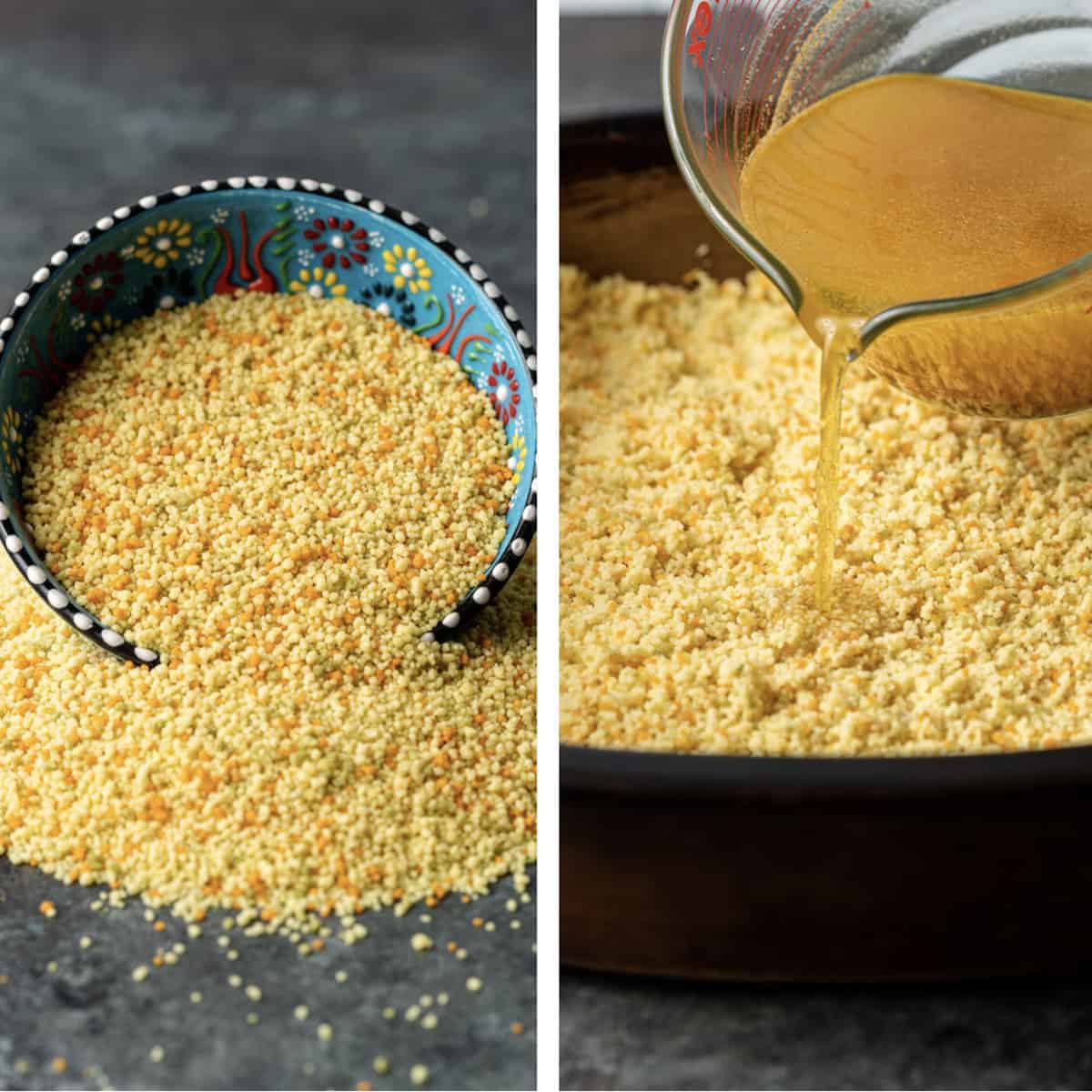
Ingredients for Moroccan Couscous
Note: This is just a partial list of ingredients. For the full ingredient list, see the recipe card at the bottom of this post.
- Couscous – There are several different kinds of couscous, so be sure to choose the pearled variety. It’s the smallest form of couscous and should be easy to find in any US supermarket.
- Slivered almonds – Instead of using them raw, toast the almonds to release the oils and enhance the overall flavor. Not only will they add crunch to the salad, but they’ll pair beautifully with the nutty flavor of the grain.
- Pomegranate seeds – These add extra color, texture, and flavor to this African couscous recipe. It’s best to use fresh arils, and you can find instructions on how to remove them in the recipe notes below.
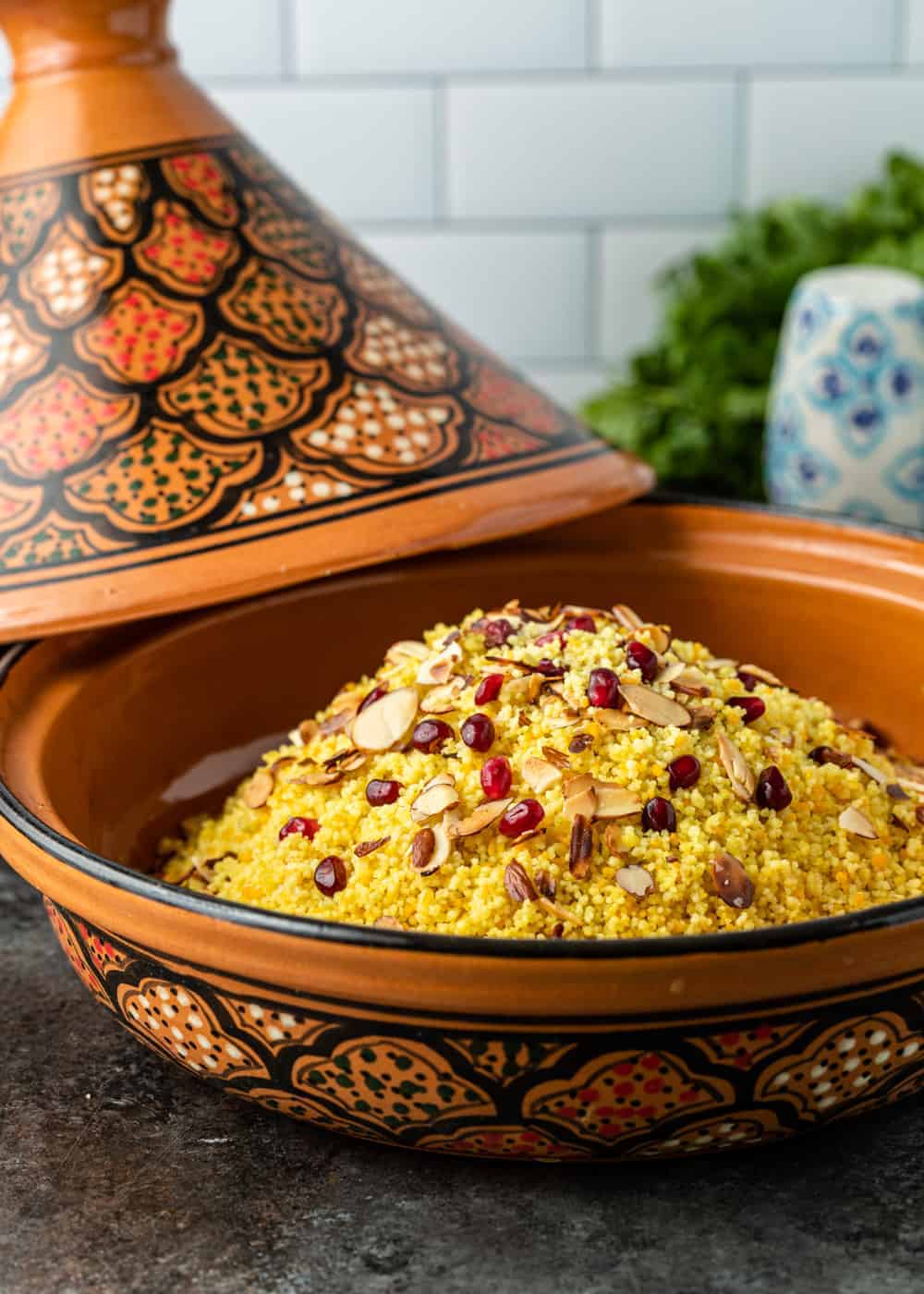
Recipe Video
This is an easy side dish to make, and it comes together quickly too. To see the process from start to finish, be sure to watch the video in the recipe card at the bottom of this post!
Tips for Cooking Couscous
The key to cooking couscous is using seasoned water, never plain, to infuse the dish with flavor.
Also, it’s important to remember that couscous needs to be steamed, not boiled. Boiling takes the life out of the grain, while steaming creates a perfectly moist and tender bite.
Instructions
- Soak the couscous:
Whisk together the warm water and seasoning (curry powder or Moroccan spice blend), then pour over the couscous in a large baking dish. Let sit for about 10 minutes so the grains can absorb the liquid. - Massage and bake:
Next, pour olive oil over the grains and work your hands through the mixture to coat every grain and break up any clumps. Then, drop small pieces of butter over the top, cover with foil, and bake.
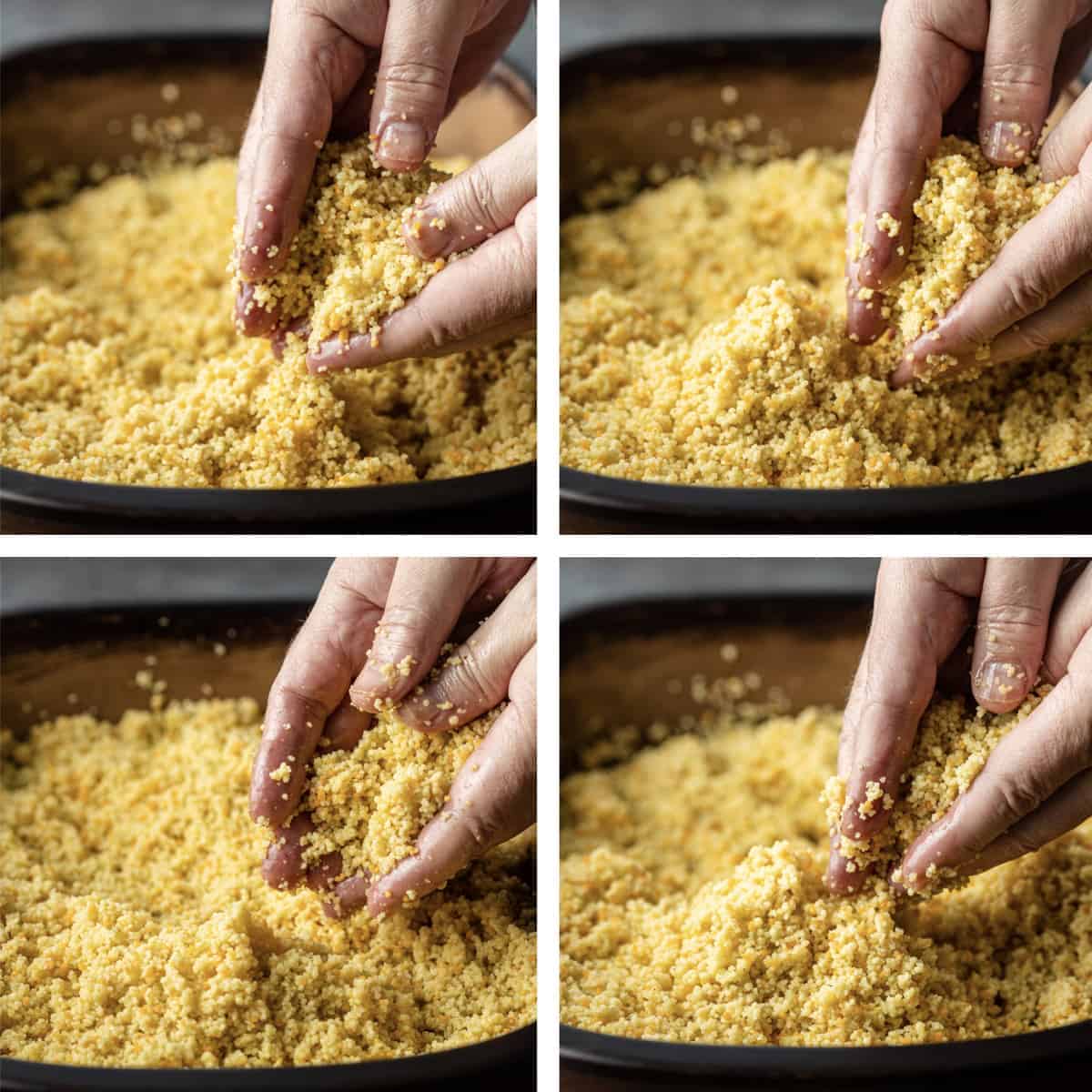
- Fluff and serve:
Once done, remove the pan from the oven and let it rest before fluffing the grains thoroughly with a fork. Serve on a large platter with the toasted almonds and pomegranate seeds scattered over the top.
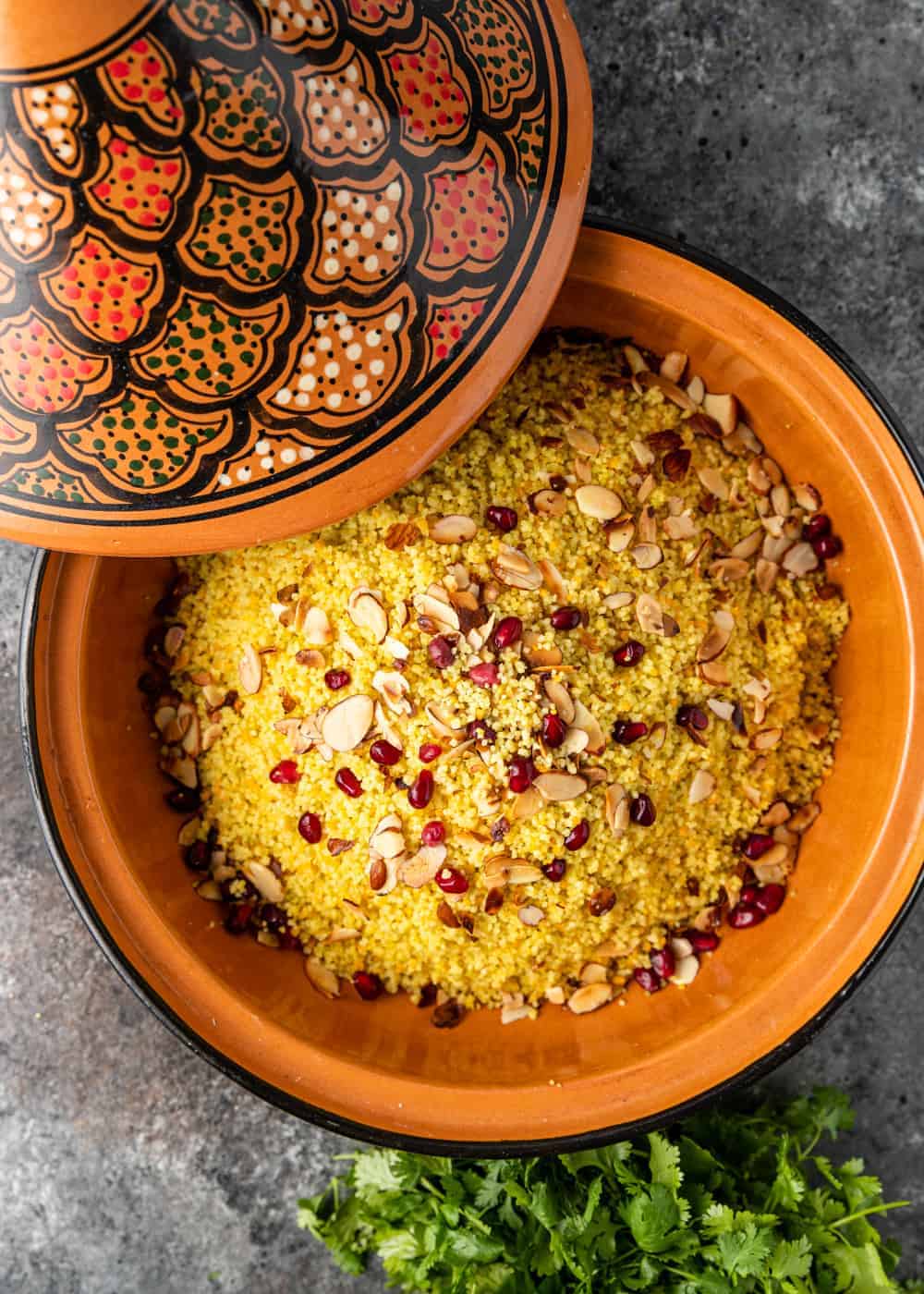
Moroccan Couscous Recipe notes
- Leftovers – Store the couscous with pomegranate in an airtight container in the refrigerator for up to 3 days. Reheat on the stove or in the microwave, adding a splash of water or vegetable stock to rehydrate the grains as needed.
- Freezing – Allow the dish to cool completely, then transfer to an airtight container and freeze for up to 3 months. Thaw in the refrigerator overnight before reheating.
- Make it more filling – If you’d like, try mixing some roasted vegetables, chickpeas, or peppers into the cooked couscous for a complete vegetarian meal.
- Play with different flavors – Because this recipe is so simple, you could easily make it without the almonds and pomegranates or try different seasonings for the soak.
How to remove seeds from a pomegranate
There are several different methods for removing those delicious, juicy arils, but this seems to be the most popular:
- Start by rolling the pomegranate around on the counter to loosen the seeds
- Next, run a paring knife around the middle of the fruit, cutting just deep enough to get through the rind.
- Pull apart the two halves, then hold them cut-side down over a bowl of water and tap the outside with a wooden spoon. Squeeze gently while doing this until all of the seeds are released.
- Finally, scoop the pomegranate arils out of the water with your hands or a slotted spoon.
Tip:
If there are still some seeds stuck inside, break the fruit into smaller pieces and submerge them in the water. Then, use your fingers to release the remaining seeds.
Subscribe to my Newsletter, follow me on Facebook, Pinterest, Instagram and YouTube for all my latest recipes and videos.
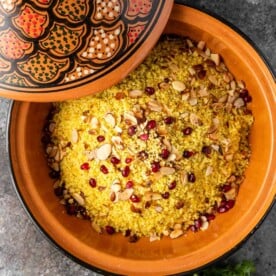
Moroccan Couscous with Pomegranate
Ingredients
- 2 cups couscous rinsed and drained
- 1 tsp Moroccan spice blend or curry powder
- 1 tsp kosher salt
- 1 ⅔ cups warm water or chicken stock
- 2 tbsp olive oil
- 3 tbsp butter divided
Garnish
- ¼ cup slivered almonds blanched
- ¼ cup pomegranate seeds (arils)
Instructions
- Preheat oven to 350°F. Place the couscous in an 13×9″ baking dish.
- In a small bowl whisk the curry powder, salt and warm water together. Pour over the couscous in the baking dish. Stir to incorporate and allow to absorb all liquid for about 10 minutes.
- Pour 2 tablespoons of the olive oil over the couscous and using your hands rub the couscous between your fingers, making sure to coat the grains and break up any lumps.
- Dot the top of the couscous with 2 tablespoons of the butter, cover with aluminum foil and bake for 15 minutes.
- In a small sauté pan lightly toast and brown the almonds in the remaining tablespoon of butter and sprinkle salt on top. Set aside on a paper towel to drain.
- Take the couscous from oven, let rest 5 minutes. Remove aluminum foil and fluff the couscous with a fork. Pile it on to a serving dish and scatter pomegranate seeds and almonds on top. Serve hot.
Video
Nutrition
The information shown is an estimate provided by an online nutrition calculator. It should not be considered a substitute for a professional nutritionist’s advice.
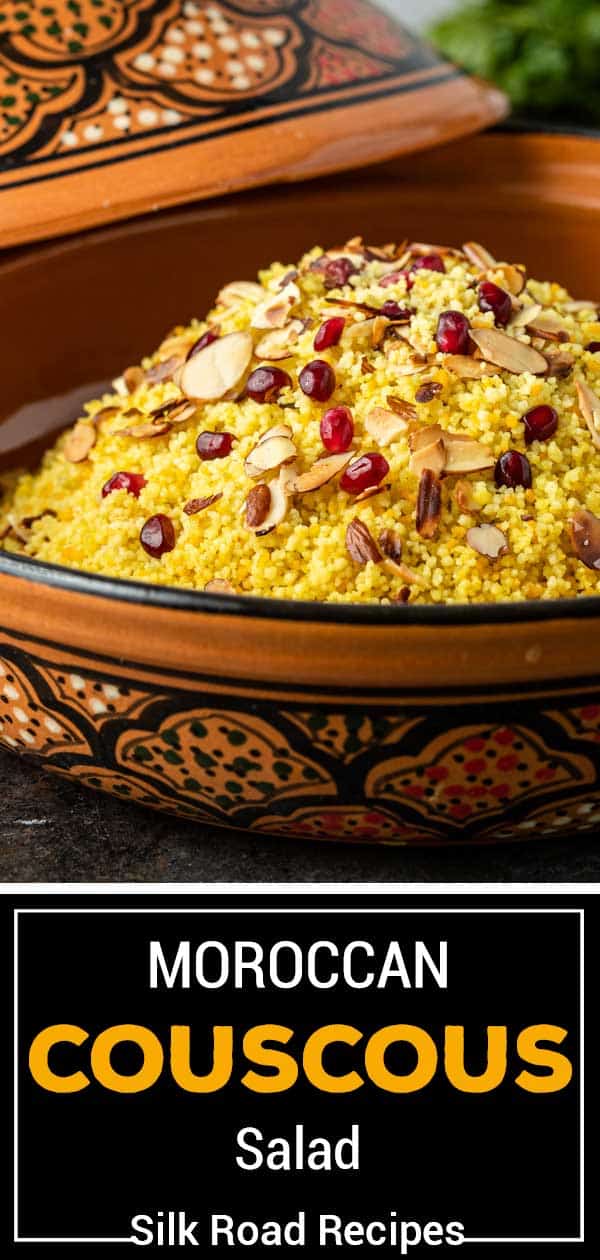
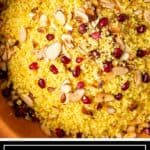
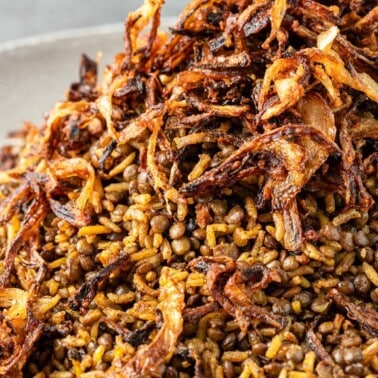
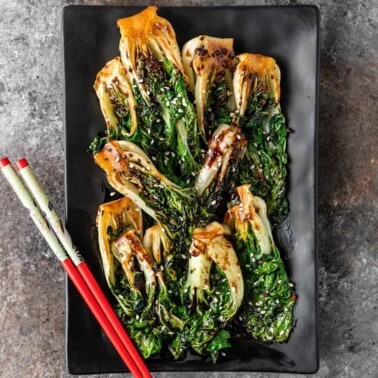
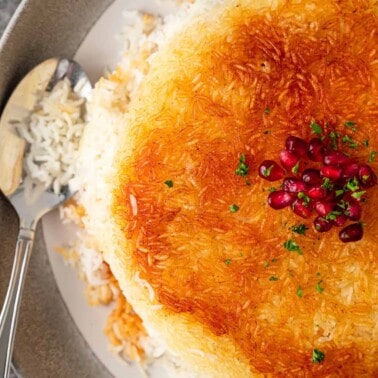
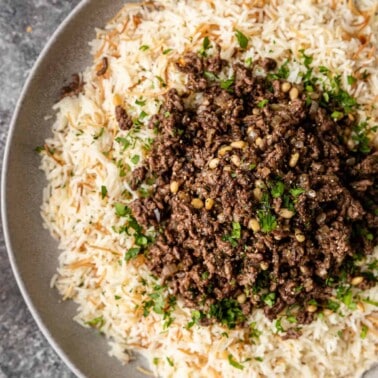








Such a fantastic couscous salad! I can’t wait to make this!
Thanks Beti!
I LOVE couscous salad! This looks absolutely amazing! YUM!
Me too Katerina! I am glad you enjoy it!
I absolutely LOVE couscous and love these seasonings!
I do too Cathy! Thanks for sharing!
Thanks for the recipe x unfortunately lacked flavour for my family. My 5yr old did elevate the flavour with her addition of redcurrant jelly(we served this with roast chicken). I will definitely try your recipe again but use stock instead of water.
Wow, even with using the curry powder (or Moroccan spice blend)? Thanks for trying it and coming back to let me know Kubeshinee. BTW, I do prefer to use chicken stock in this, not water (but it’s an option) if that helps.
Love couscous! I am always looking for new couscous salads!
I hope you enjoy it! I love it myself!
Such a great addition by adding the pomegranate! Gives it not only a pop of flavor but of color too. Love it!
I am so glad you enjoyed it!
My daughter is going to love this recipe! I can’t wait to give this a try! So excited! Looks amazing and so delicious!
I hope you enjoy it as much as we do!